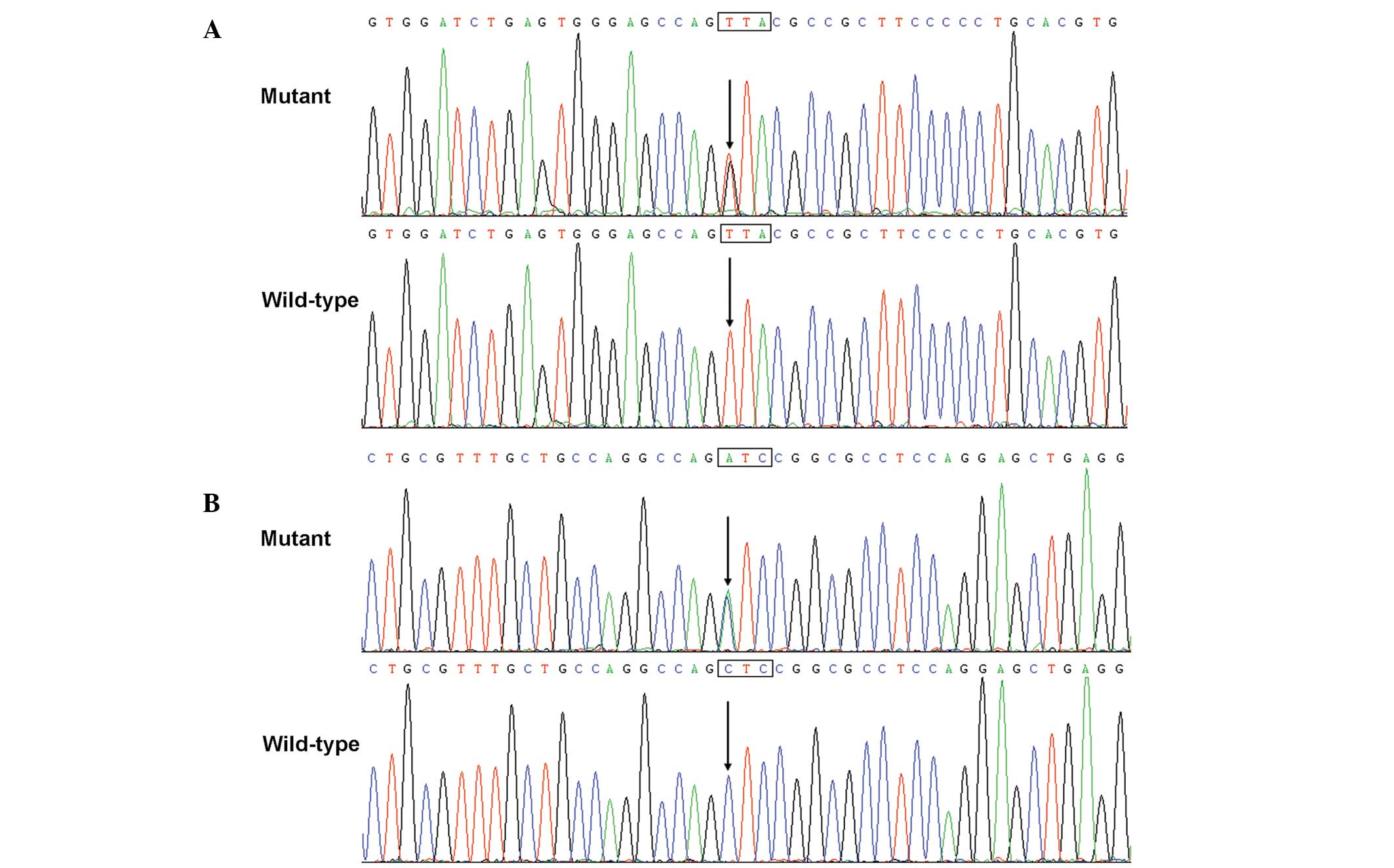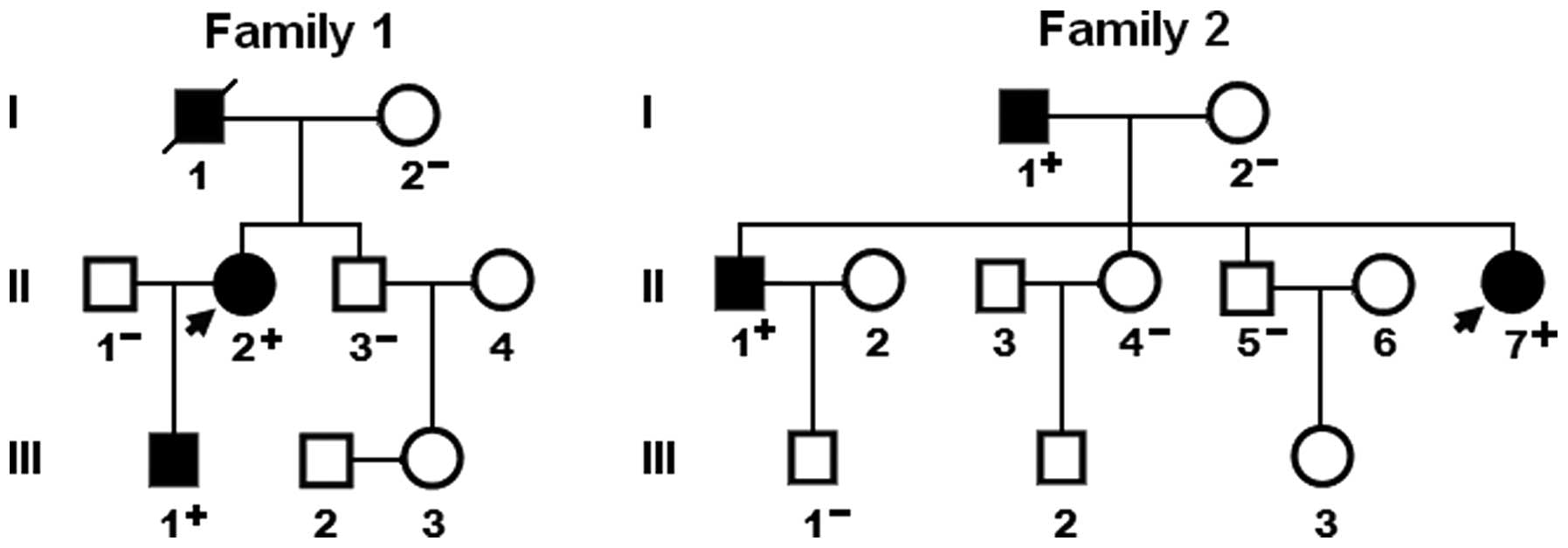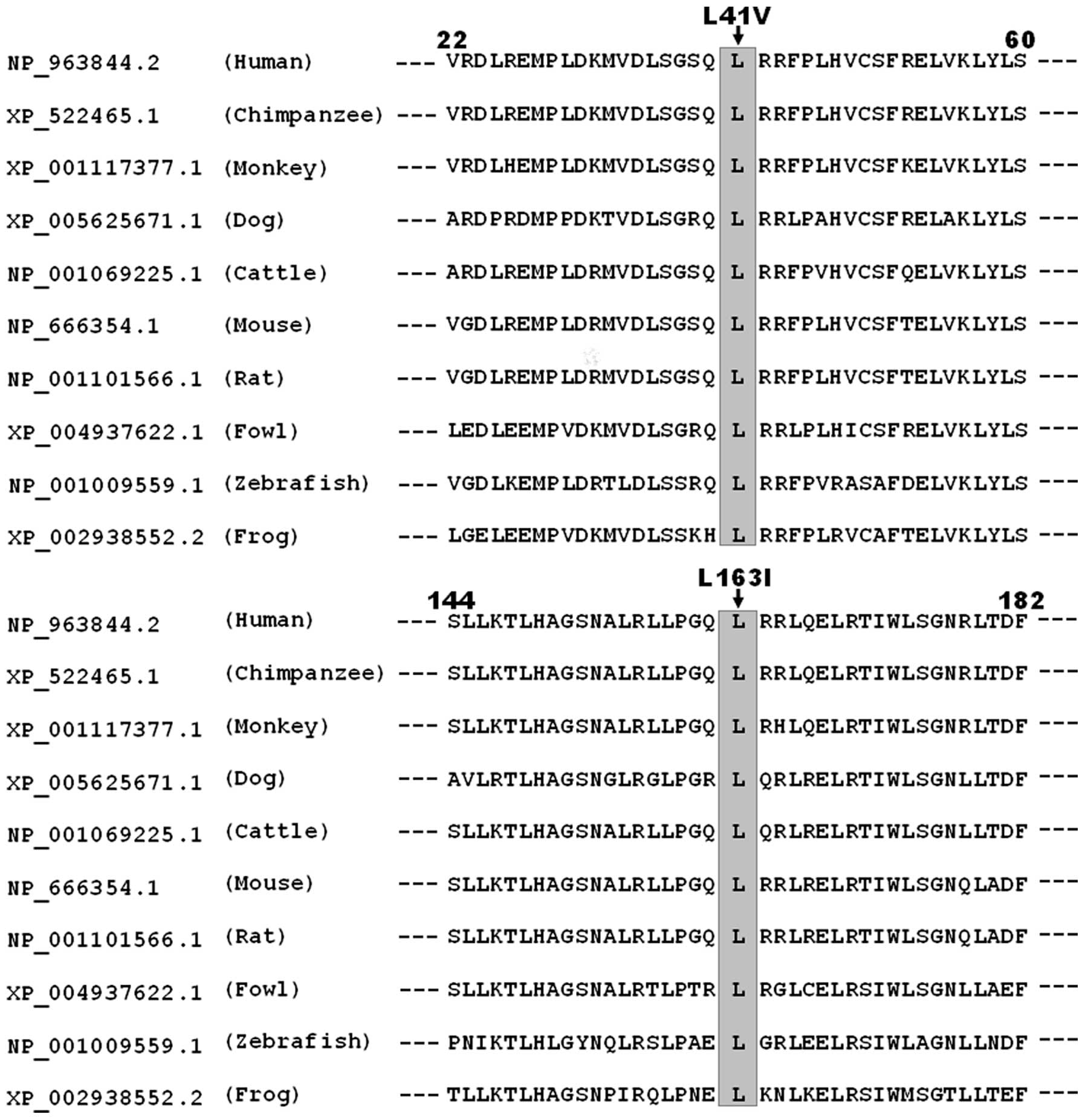|
1
|
McNally EM, Golbus JR and Puckelwartz MJ:
Genetic mutations and mechanisms in dilated cardiomyopathy. J Clin
Invest. 123:19–26. 2013. View
Article : Google Scholar : PubMed/NCBI
|
|
2
|
Koutalas E, Kanoupakis E and Vardas P:
Sudden cardiac death in non-ischemic dilated cardiomyopathy: a
critical appraisal of existing and potential risk stratification
tools. Int J Cardiol. 167:335–341. 2013. View Article : Google Scholar
|
|
3
|
Alexander PM, Daubeney PE, Nugent AW, Lee
KJ, Turner C, Colan SD, Robertson T, Davis AM, Ramsay J, Justo R,
Sholler GF, et al: National Australian childhood cardiomy-opathy
study: Long-term outcomes of dilated cardiomyopathy diagnosed
during childhood: results from a national population-based study of
childhood cardiomyopathy. Circulation. 128:2039–2046. 2013.
View Article : Google Scholar : PubMed/NCBI
|
|
4
|
Yoshikawa T: Contribution of acquired
factors to the pathogenesis of dilated cardiomyopathy: The cause of
dilated cardiomyopathy: Genetic or acquired? (Acquired-Side). Circ
J. 75:1766–1773. 2011. View Article : Google Scholar
|
|
5
|
Wahbi K, Béhin A, Bécane HM, Leturcq F,
Cossée M, Laforêt P, Stojkovic T, Carlier P, Toussaint M, Gaxotte
V, Cluzel P, et al: Dilated cardiomyopathy in patients with
mutations in anoctamin 5. Int J Cardiol. 168:76–79. 2013.
View Article : Google Scholar
|
|
6
|
Ruppert V, Meyer T, Richter A, Maisch B
and Pankuweit S: German competence network of heart failure:
Identification of a missense mutation in the melusin-encoding
ITGB1BP2 gene in a patient with dilated cardiomyopathy. Gene.
512:206–210. 2013. View Article : Google Scholar
|
|
7
|
Luo R, Li X, Fan X, Yuan W and Wu X:
Association of tumor necrosis factor-α gene G-308A polymorphism
with dilated cardiomyopathy: a meta-analysis. DNA Cell Biol.
32:130–137. 2013. View Article : Google Scholar : PubMed/NCBI
|
|
8
|
Meyer T, Ruppert V, Ackermann S, Richter
A, Perrot A, Sperling SR, Posch MG, Maisch B and Pankuweit S:
German competence network heart failure: Novel mutations in the
sarcomeric protein myopalladin in patients with dilated
cardio-myopathy. Eur J Hum Genet. 21:294–300. 2013. View Article : Google Scholar :
|
|
9
|
Xi HL, Liu JF, Li L and Wan J:
Relationship between dilated cardiomyopathy and the E23K and I337V
polymorphisms in the Kir6.2 subunit of the KATP channel. Genet Mol
Res. 12:4383–4392. 2013. View Article : Google Scholar : PubMed/NCBI
|
|
10
|
Pankuweit S, Ruppert V, Jónsdóttir T,
Müller HH and Meyer T: German competence network of heart failure:
The HLA class II allele DQB1 0309 is associated with dilated
cardiomyopathy. Gene. 531:180–183. 2013. View Article : Google Scholar : PubMed/NCBI
|
|
11
|
Li RG, Li L, Qiu XB, Yuan F, Xu L, Li X,
Xu YJ, Jiang WF, Jiang JQ, Liu X, Fang WY, et al: GATA4
loss-of-function mutation underlies familial dilated
cardiomyopathy. Biochem Biophys Res Commun. 439:591–596. 2013.
View Article : Google Scholar : PubMed/NCBI
|
|
12
|
Paavola J, Schliffke S, Rossetti S, Kuo
IY, Yuan S, Sun Z, Harris PC, Torres VE and Ehrlich BE:
Polycystin-2 mutations lead to impaired calcium cycling in the
heart and predispose to dilated cardiomyopathy. J Mol Cell Cardiol.
58:199–208. 2013. View Article : Google Scholar : PubMed/NCBI
|
|
13
|
Wells QS, Becker JR, Su YR, Mosley JD,
Weeke P, D'Aoust L, Ausborn NL, Ramirez AH, Pfotenhauer JP,
Naftilan AJ, Markham L, et al: Whole exome sequencing identifies a
causal RBM20 mutation in a large pedigree with familial dilated
cardiomyopathy. Circ Cardiovasc Genet. 6:317–326. 2013. View Article : Google Scholar : PubMed/NCBI
|
|
14
|
Dhandapany PS, Razzaque MA, Muthusami U,
Kunnoth S, Edwards JJ, Mulero-Navarro S, Riess I, Pardo S, Sheng J,
Rani DS, Rani B, et al: RAF1 mutations in childhood-onset dilated
cardiomyopathy. Nat Genet. 46:635–639. 2014. View Article : Google Scholar : PubMed/NCBI
|
|
15
|
Amin AS: SCN5A-related dilated
cardiomyopathy: What do we know? Heart Rhythm. 11:1454–1455. 2014.
View Article : Google Scholar : PubMed/NCBI
|
|
16
|
Li J, Liu WD, Yang ZL, Yuan F, Xu L, Li RG
and Yang YQ: Prevalence and spectrum of GATA4 mutations associated
with sporadic dilated cardiomyopathy. Gene. 548:174–181. 2014.
View Article : Google Scholar : PubMed/NCBI
|
|
17
|
Petchey LK, Risebro CA, Vieira JM, Roberts
T, Bryson JB, Greensmith L, Lythgoe MF and Riley PR: Loss of Prox1
in striated muscle causes slow to fast skeletal muscle fiber
conversion and dilated cardiomyopathy. Proc Natl Acad Sci USA.
111:9515–9520. 2014. View Article : Google Scholar : PubMed/NCBI
|
|
18
|
Zhao L, Xu JH, Xu WJ, Yu H, Wang Q, Zheng
HZ, Jiang WF, Jiang JF and Yang YQ: A novel GATA4 loss-of-function
mutation responsible for familial dilated cardiomyopathy. Int J Mol
Med. 33:654–660. 2014.
|
|
19
|
Zhang M, Chen J, Si D, Zheng Y, Jiao H,
Feng Z, Hu Z and Duan R: Whole exome sequencing identifies a novel
EMD mutation in a Chinese family with dilated cardiomyopathy. BMC
Med Genet. 15:772014. View Article : Google Scholar : PubMed/NCBI
|
|
20
|
Matsa LS, Sagurthi SR, Ananthapur V, Nalla
S and Nallari P: Endothelin 1 gene as a modifier in dilated
cardiomyopathy. Gene. 548:256–262. 2014. View Article : Google Scholar : PubMed/NCBI
|
|
21
|
Franaszczyk M, Bilinska ZT,
Sobieszczańska-Małek M, Michalak E, Sleszycka J, Sioma A, Małek ŁA,
Kaczmarska D, Walczak E, Włodarski P, Hutnik Ł, et al: The BAG3
gene variants in Polish patients with dilated cardiomyopathy: four
novel mutations and a genotype-phenotype correlation. J Transl Med.
12:1922014. View Article : Google Scholar : PubMed/NCBI
|
|
22
|
Flack E and Kannankeril PJ: The genetics
of dilated cardiomyopathy. Heart Rhythm. 9:397–398. 2012.
View Article : Google Scholar
|
|
23
|
Kobe B and Deisenhofer J: Proteins with
leucine-rich repeats. Curr Opin Struct Biol. 5:409–416. 1995.
View Article : Google Scholar : PubMed/NCBI
|
|
24
|
Yan J and Aldrich RW: LRRC26 auxiliary
protein allows BK channel activation at resting voltage without
calcium. Nature. 466:513–516. 2010. View Article : Google Scholar : PubMed/NCBI
|
|
25
|
Will RD, Eden M, Just S, Hansen A, Eder A,
Frank D, Kuhn C, Seeger TS, Oehl U, Wiemann S, Korn B, et al:
Myomasp/LRRC39, a heart- and muscle-specific protein, is a novel
component of the sarcomeric M-band and is involved in stretch
sensing. Circ Res. 107:1253–1264. 2010. View Article : Google Scholar : PubMed/NCBI
|
|
26
|
Kim KH, Kim TG, Micales BK, Lyons GE and
Lee Y: Dynamic expression patterns of leucine-rich repeat
containing protein 10 in the heart. Dev Dyn. 236:2225–2234. 2007.
View Article : Google Scholar : PubMed/NCBI
|
|
27
|
Nakane T, Satoh T, Inada Y, Nakayama J,
Itoh F and Chiba S: Molecular cloning and expression of HRLRRP, a
novel heart-restricted leucine-rich repeat protein. Biochem Biophys
Res Commun. 314:1086–1092. 2004. View Article : Google Scholar : PubMed/NCBI
|
|
28
|
Adameyko II, Mudry RE, Houston-Cummings
NR, Veselov AP, Gregorio CC and Tevosian SG: Expression and
regulation of mouse SERDIN1, a highly conserved cardiac-specific
leucine-rich repeat protein. Dev Dyn. 233:540–552. 2005. View Article : Google Scholar : PubMed/NCBI
|
|
29
|
Kim KH, Antkiewicz DS, Yan L, Eliceiri KW,
Heideman W, Peterson RE and Lee Y: Lrrc10 is required for early
heart development and function in zebrafish. Dev Biol. 308:494–506.
2007. View Article : Google Scholar : PubMed/NCBI
|
|
30
|
Brody MJ, Hacker TA, Patel JR, Feng L,
Sadoshima J, Tevosian SG, Balijepalli RC, Moss RL and Lee Y:
Ablation of the cardiac-specific gene leucine-rich repeat
containing 10 (Lrrc10) results in dilated cardiomyopathy. PLoS One.
7:e516212012. View Article : Google Scholar : PubMed/NCBI
|
|
31
|
Olson TM, Michels VV, Thibodeau SN, Tai YS
and Keating MT: Actin mutations in dilated cardiomyopathy, a
heritable form of heart failure. Science. 280:750–752. 1998.
View Article : Google Scholar : PubMed/NCBI
|
|
32
|
Mohapatra B, Jimenez S, Lin JH, Bowles KR,
Coveler KJ, Marx JG, Chrisco MA, Murphy RT, Lurie PR, Schwartz RJ,
Elliott PM, et al: Mutations in the muscle LIM protein and
alpha-actinin-2 genes in dilated cardiomyopathy and endocardial
fibroelastosis. Mol Genet Metab. 80:207–215. 2003. View Article : Google Scholar : PubMed/NCBI
|
|
33
|
Elliott P, O'Mahony C, Syrris P, Evans A,
Rivera Sorensen C, Sheppard MN, Carr-White G, Pantazis A and
McKenna WJ: Prevalence of desmosomal protein gene mutations in
patients with dilated cardiomyopathy. Circ Cardiovasc Genet.
3:314–322. 2010. View Article : Google Scholar : PubMed/NCBI
|
|
34
|
Luther PK: The vertebrate muscle Z-disc:
sarcomere anchor for structure and signalling. J Muscle Res Cell
Motil. 30:171–185. 2009. View Article : Google Scholar : PubMed/NCBI
|
|
35
|
Frank D and Frey N: Cardiac Z-disc
signaling network. J Biol Chem. 286:9897–9904. 2011. View Article : Google Scholar : PubMed/NCBI
|
|
36
|
Ervasti JM: Costameres: the Achilles' heel
of Herculean muscle. J Biol Chem. 278:13591–13594. 2003. View Article : Google Scholar : PubMed/NCBI
|
|
37
|
Hoshijima M: Mechanical stress-strain
sensors embedded in cardiac cytoskeleton: Z disk, titin and
associated structures. Am J Physiol Heart Circ Physiol.
290:H1313–H1325. 2006. View Article : Google Scholar : PubMed/NCBI
|
|
38
|
Zheng M, Cheng H, Li X, Zhang J, Cui L,
Ouyang K, Han L, Zhao T, Gu Y, Dalton ND, Bang ML, et al:
Cardiac-specific ablation of Cypher leads to a severe form of
dilated cardiomyopathy with premature death. Hum Mol Genet.
18:701–713. 2009. View Article : Google Scholar :
|
|
39
|
Arber S, Hunter JJ, Ross J Jr, Hongo M,
Sansig G, Borg J, Perriard JC, Chien KR and Caroni P: MLP-deficient
mice exhibit a disruption of cardiac cytoarchitectural
organization, dilated cardiomyopathy and heart failure. Cell.
88:393–403. 1997. View Article : Google Scholar : PubMed/NCBI
|
|
40
|
Cheng H, Kimura K, Peter AK, Cui L, Ouyang
K, Shen T, Liu Y, Gu Y, Dalton ND, Evans SM, Knowlton KU, et al:
Loss of enigma homolog protein results in dilated cardiomyopathy.
Circ Res. 107:348–356. 2010. View Article : Google Scholar : PubMed/NCBI
|
|
41
|
White DE, Coutu P, Shi YF, Tardif JC,
Nattel S, St Arnaud R, Dedhar S and Muller WJ: Targeted ablation of
ILK from the murine heart results in dilated cardiomyopathy and
spontaneous heart failure. Genes Dev. 20:2355–2360. 2006.
View Article : Google Scholar : PubMed/NCBI
|
|
42
|
Zemljic-Harpf AE, Miller JC, Henderson SA,
Wright AT, Manso AM, Elsherif L, Dalton ND, Thor AK, Perkins GA,
McCulloch AD and Ross RS: Cardiac-myocyte-specific excision of the
vinculin gene disrupts cellular junctions, causing sudden death or
dilated cardiomyopathy. Mol Cell Biol. 27:7522–7537. 2007.
View Article : Google Scholar : PubMed/NCBI
|
|
43
|
Vatta M, Mohapatra B, Jimenez S, Sanchez
X, Faulkner G, Perles Z, Sinagra G, Lin JH, Vu TM, Zhou Q, Bowles
KR, et al: Mutations in Cypher/ZASP in patients with dilated
cardiomyopathy and left ventricular non-compaction. J Am Coll
Cardiol. 42:2014–2027. 2003. View Article : Google Scholar : PubMed/NCBI
|
|
44
|
Knöll R, Hoshijima M, Hoffman HM, Person
V, Lorenzen-Schmidt I, Bang ML, Hayashi T, Shiga N, Yasukawa H,
Schaper W, McKenna W, et al: The cardiac mechanical stretch sensor
machinery involves a Z disc complex that is defective in a subset
of human dilated cardiomyopathy. Cell. 111:943–955. 2002.
View Article : Google Scholar
|
|
45
|
Hassel D, Dahme T, Erdmann J, Meder B,
Huge A, Stoll M, Just S, Hess A, Ehlermann P, Weichenhan D,
Grimmler M, et al: Nexilin mutations destabilize cardiac Z-disks
and lead to dilated cardiomyopathy. Nat Med. 15:1281–1288. 2009.
View Article : Google Scholar : PubMed/NCBI
|
|
46
|
Duboscq-Bidot L, Xu P, Charron P, Neyroud
N, Dilanian G, Millaire A, Bors V, Komajda M and Villard E:
Mutations in the Z-band protein myopalladin gene and idiopathic
dilated cardio-myopathy. Cardiovasc Res. 77:118–125. 2008.
View Article : Google Scholar
|
|
47
|
Knöll R, Postel R, Wang J, Krätzner R,
Hennecke G, Vacaru AM, Vakeel P, Schubert C, Murthy K, Rana BK,
Kube D, et al: Lamininalpha4 and integrin-linked kinase mutations
cause human cardiomyopathy via simultaneous defects in
cardiomyocytes and endothelial cells. Circulation. 116:515–525.
2007. View Article : Google Scholar
|
|
48
|
Li D, Tapscoft T, Gonzalez O, Burch PE,
Quiñones MA, Zoghbi WA, Hill R, Bachinski LL, Mann DL and Roberts
R: Desmin mutation responsible for idiopathic dilated
cardiomyopathy. Circulation. 100:461–464. 1999. View Article : Google Scholar : PubMed/NCBI
|
|
49
|
Brody MJ, Cho E, Mysliwiec MR, Kim TG,
Carlson CD, Lee KH and Lee Y: Lrrc10 is a novel cardiac-specific
target gene of Nkx2-5 and GATA4. J Mol Cell Cardiol. 62:237–246.
2013. View Article : Google Scholar : PubMed/NCBI
|
|
50
|
Pashmforoush M, Lu JT, Chen H, Amand TS,
Kondo R, Pradervand S, Evans SM, Clark B, Feramisco JR, Giles W, Ho
SY, et al: Nkx2-5 pathways and congenital heart disease; loss of
ventricular myocyte lineage specification leads to progressive
cardiomyopathy and complete heart block. Cell. 117:373–386. 2004.
View Article : Google Scholar : PubMed/NCBI
|
|
51
|
Costa MW, Guo G, Wolstein O, Vale M,
Castro ML, Wang L, Otway R, Riek P, Cochrane N, Furtado M,
Semsarian C, et al: Functional characterization of a novel mutation
in NKX2-5 associated with congenital heart disease and adult-onset
cardiomyopathy. Circ Cardiovasc Genet. 6:238–247. 2013. View Article : Google Scholar : PubMed/NCBI
|
|
52
|
Gutierrez-Roelens I, De Roy L, Ovaert C,
Sluysmans T, Devriendt K, Brunner HG and Vikkula M: A novel
CSX/NKX2-5 mutation causes autosomal-dominant AV block: are atrial
fibrillation and syncopes part of the phenotype? Eur J Hum Genet.
14:1313–1316. 2006. View Article : Google Scholar : PubMed/NCBI
|
|
53
|
Huang RT, Xue S, Xu YJ, Zhou M and Yang
YQ: A novel NKX2.5 loss-of-function mutation responsible for
familial atrial fibrillation. Int J Mol Med. 31:1119–1126.
2013.PubMed/NCBI
|
|
54
|
Xie WH, Chang C, Xu YJ, Li RG, Qu XK, Fang
WY, Liu X and Yang YQ: Prevalence and spectrum of Nkx2.5 mutations
associated with idiopathic atrial fibrillation. Clinics (Sao
Paulo). 68:777–784. 2013. View Article : Google Scholar
|
|
55
|
Yu H, Xu JH, Song HM, Zhao L, Xu WJ, Wang
J, Li RG, Xu L, Jiang WF, Qiu XB, Jiang JQ, et al: Mutational
spectrum of the NKX2-5 gene in patients with lone atrial
fibrillation. Int J Med Sci. 11:554–563. 2014. View Article : Google Scholar : PubMed/NCBI
|
|
56
|
Posch MG, Boldt LH, Polotzki M, Richter S,
Rolf S, Perrot A, Dietz R, Ozcelik C and Haverkamp W: Mutations in
the cardiac transcription factor GATA4 in patients with lone atrial
fibrillation. Eur J Med Genet. 53:201–203. 2010. View Article : Google Scholar : PubMed/NCBI
|
|
57
|
Yang YQ, Wang MY, Zhang XL, Tan HW, Shi
HF, Jiang WF, Wang XH, Fang WY and Liu X: GATA4 loss-of-function
mutations in familial atrial fibrillation. Clin Chim Acta.
412:1825–1830. 2011. View Article : Google Scholar : PubMed/NCBI
|
|
58
|
Jiang JQ, Shen FF, Fang WY, Liu X and Yang
YQ: Novel GATA4 mutations in lone atrial fibrillation. Int J Mol
Med. 28:1025–1032. 2011.PubMed/NCBI
|
|
59
|
Wang J, Sun YM and Yang YQ: Mutation
spectrum of the GATA4 gene in patients with idiopathic atrial
fibrillation. Mol Biol Rep. 39:8127–8135. 2012. View Article : Google Scholar : PubMed/NCBI
|












